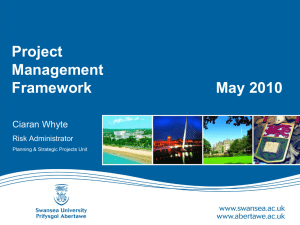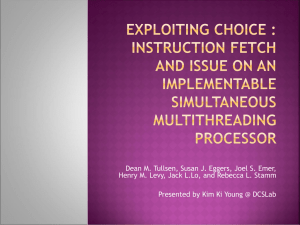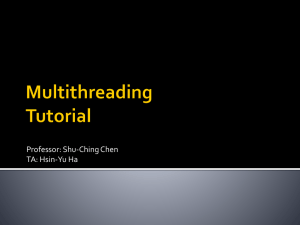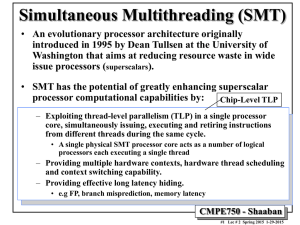Simultaneous Multithreading - Computer Science Department
advertisement
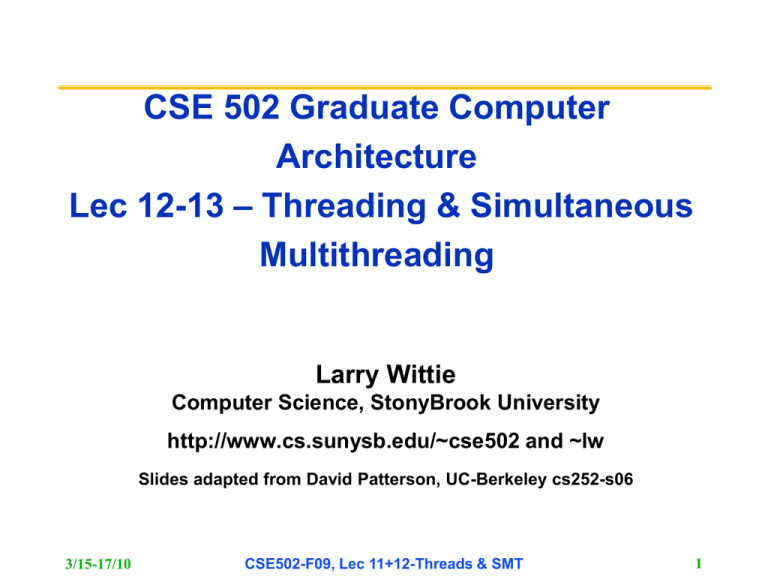
CSE 502 Graduate Computer Architecture Lec 12-13 – Threading & Simultaneous Multithreading Larry Wittie Computer Science, StonyBrook University http://www.cs.sunysb.edu/~cse502 and ~lw Slides adapted from David Patterson, UC-Berkeley cs252-s06 3/15-17/10 CSE502-F09, Lec 11+12-Threads & SMT 1 Outline • • • • • • • Thread Level Parallelism (from H&P Chapter 3) Multithreading Simultaneous Multithreading Power 4 vs. Power 5 Head to Head: VLIW vs. Superscalar vs. SMT Commentary Conclusion • Read Chapter 3 of Text • Next Reading Assignment: Vector Appendix F 3/15-17/10 CSE502-F09, Lec 11+12-Threads & SMT 2 Performance beyond single thread ILP • ILP for arbitrary code is limited now to 3 to 6 issues/cycle, there can be much higher natural parallelism in some applications (e.g., database or scientific codes) • Explicit (specified by compiler) Thread Level Parallelism or Data Level Parallelism • Thread: a process with its own instructions and data (or much harder on compiler: carefully selected, rarely interacting code segments in the same process) – A thread may be one process that is part of a parallel program of multiple processes, or it may be an independent program – Each thread has all the state (instructions, data, PC, register state, and so on) necessary to allow it to execute • Data Level Parallelism: Perform identical (lockstep) operations on data and have lots of data 3/15-17/10 CSE502-F09, Lec 11+12-Threads & SMT 3 Thread Level Parallelism (TLP) • ILP (last lectures) exploits implicitly parallel operations within a loop or straight-line code segment • TLP is explicitly represented by the use of multiple threads of execution that are inherently parallel • Goal: Use multiple instruction streams to improve 1. Throughput of computers that run many programs 2. Execution time of multi-threaded programs • TLP could be more cost-effective to exploit than ILP for many applications. 3/15-17/10 CSE502-F09, Lec 11+12-Threads & SMT 4 New Approach: Multithreaded Execution • Multithreading: multiple threads to share the functional units of one processor via overlapped execution – processor must duplicate independent state of each thread, e.g., a separate copy of register file, a separate PC, and if running as independent programs, a separate page table – memory shared through the virtual memory mechanisms, which already support multiple processes – HW for fast thread switch (0.1 to 10 clocks) is much faster than a full process switch (100s to 1000s of clocks) that copies state (state = registers and memory) • When switch among threads? – Alternate instructions from new threads (fine grain) – When a thread is stalled, perhaps for a cache miss, another thread can be executed (coarse grain) – In cache-less multiprocessors, at start of each memory access 3/15-17/10 CSE502-F09, Lec 11+12-Threads & SMT 5 For most applications, the processing units stall 80% or more of time during “execution” Just 18% of issue slots OK for an 8-way superscalar. <=#1 <=#2 18 18% CPU issue slots usefully busy From: Tullsen, Eggers, and Levy, “Simultaneous Multithreading: Maximizing On-chip Parallelism, ISCA 1995. (From U Wash.) 3/15-17/10 CSE502-F09, Lec 11+12-Threads & SMT 6 Multithreading Categories Time (processor cycle) Pipes: 1 2 3 4 Superscalar 16/48 = 33.3% FUs: 1 2 3 4 New Thread/cyc Many Cyc/thread Separate Jobs Simultaneous Fine-Grained Coarse-Grained Multiprocessing Multithreading 27/48 = 56.3% Thread 1 Thread 2 3/15-17/10 27/48 = 56.3% 29/48 = 60.4% Thread 3 Thread 4 CSE502-F09, Lec 11+12-Threads & SMT 42/48 = 87.5% Thread 5 Idle slot 7 Fine-Grained Multithreading • Switches between threads on each instruction cycle, causing the execution of multiple threads to be interleaved • Usually done in a round-robin fashion, skipping any stalled threads • CPU must be able to switch threads every clock • Advantage is that it can hide both short and long stalls, since instructions from other threads executed when one thread stalls • Disadvantage is it slows down execution of individual threads, since a thread ready to execute without stalls will be delayed by instructions from other threads • Used on Sun’s Niagara chip (with 8 cores, will see later) 3/15-17/10 CSE502-F09, Lec 11+12-Threads & SMT 8 Course-Grained Multithreading • Switches threads for costly stalls, such as L2 cache misses (or on any data memory reference if no caches) • Advantages – Relieves need to have very fast thread-switching (if use caches). – Does not slow down any thread, since instructions from other threads issued only when active thread encounters a costly stall • Disadvantage is that it is hard to overcome throughput losses from shorter stalls, because of pipeline start-up costs – Since CPU normally issues instructions from just one thread, when a stall occurs, the pipeline must be emptied or frozen – New thread must fill pipeline before instructions can complete • Because of this start-up overhead, coarse-grained multithreading is efficient for reducing penalty only of high cost stalls, where stall time >> pipeline refill time • Used IBM AS/400 (1988, for small to medium businesses) 3/15-17/10 CSE502-F09, Lec 11+12-Threads & SMT 9 (U Wash => Intel) Simultaneous One thread, 8 func units Cycle M M FX FX FP FP BR CC Multi-threading … Two threads, 8 units Cycle M M FX FX FP FP BR CC 1 1 2 2 3 3 4 4 5 5 6 6 7 7 8 8 9 9 Busy: 30/72 = 41.7% Busy: 13/72 = 18.0% M = Load/Store, FX = Fixed Point, FP = Floating Point, BR = Branch, CC = Condition Codes 3/15-17/10 CSE502-F09, Lec 11+12-Threads & SMT 10 Use both ILP and TLP? (U Wash: “Yes”) • TLP and ILP exploit two different kinds of parallel structure in a program • Could a processor oriented toward ILP be used to exploit TLP? – functional units are often idle in data paths designed for ILP because of either stalls or dependences in the code • Could the TLP be used as a source of independent instructions that might keep the processor busy during stalls? • Could TLP be used to employ the functional units that would otherwise lie idle when insufficient ILP exists? 3/15-17/10 CSE502-F09, Lec 11+12-Threads & SMT 11 Simultaneous Multithreading (SMT) • Simultaneous multithreading (SMT): insight that a dynamically scheduled processor already has many HW mechanisms to support multithreading – Large set of virtual registers that can be used to hold the register sets of independent threads – Register renaming provides unique register identifiers, so instructions from multiple threads can be mixed in datapath without confusing sources and destinations across threads – Out-of-order completion allows the threads to execute out of order, and get better utilization of the HW • Just need to add a per-thread renaming table and keeping separate PCs – Independent commitment can be supported by logically keeping a separate reorder buffer for each thread Source: Micrprocessor Report, December 6, 1999 “Compaq Chooses SMT for Alpha” 3/15-17/10 CSE502-F09, Lec 11+12-Threads & SMT 12 Design Challenges in SMT • Since SMT makes sense only with fine-grained implementation, impact of fine-grained scheduling on single thread performance? – Does designating a preferred thread allow sacrificing neither throughput nor single-thread performance? – Unfortunately, with a preferred thread, processor is likely to sacrifice some throughput when the preferred thread stalls • Larger register file needed to hold multiple contexts • Try not to affect clock cycle time, especially in – Instruction issue - more candidate instructions need to be considered – Instruction completion - choosing which instructions to commit may be challenging • Ensure that cache and TLB conflicts generated by SMT do not degrade performance 3/15-17/10 CSE502-F09, Lec 11+12-Threads & SMT 13 Multithreading Categories Time (processor cycle) Pipes: 1 2 3 4 Superscalar 16/48 = 33.3% FUs: 1 2 3 4 New Thread/cyc Many Cyc/thread Separate Jobs Simultaneous Fine-Grained Coarse-Grained Multiprocessing Multithreading 27/48 = 56.3% Thread 1 Thread 2 3/15-17/10 27/48 = 56.3% 29/48 = 60.4% Thread 3 Thread 4 CSE502-F09, Lec 11+12-Threads & SMT 42/48 = 87.5% Thread 5 Idle slot 14 Power 4 Single-threaded predecessor to Power 5. Eight execution units in an out-of-order engine, each unit may issue one instruction each cycle. Instruction pipeline (IF: instruction fetch, IC: instruction cache, BP: branch predict, D0: decode stage 0, Xfer: transfer, GD: group dispatch, MP: mapping, ISS: instruction issue, RF: register file read, EX: execute, EA: compute address, DC: data caches, F6: six-cycle floating-point execution pipe, Fmt: data format, WB: write back, and CP: group commit) 3/15-17/10 CSE502-F09, Lec 11+12-Threads & SMT 15 Power 4 - 1 thread Power 5 - 2 2 completes (architected register sets) threads 2 fetch (PC), 2 initial decodes See www.ibm.com/servers/eserver/pseries/news/related/2004/m2040.pdf Power5 instruction pipeline (IF = instruction fetch, IC = instruction cache, BP = branch predict, D0 = decode stage 0, Xfer = transfer, GD = group dispatch, MP = mapping, ISS = instruction issue, RF = register file read, EX = execute, EA = compute address, DC = data caches, F6 = six-cycle floating-point execution pipe, Fmt = data format, WB = write back, and CP = group commit) Page 43. 3/15-17/10 CSE502-F09, Lec 11+12-Threads & SMT 16 Power 5 data flow ... LSU = load/store unit, FXU = fixed-point execution unit, FPU = floating-point unit, BXU = branch execution unit, and CRL = condition register logical execution unit. Why only 2 threads? With 4, some shared resource (physical registers, cache, memory bandwidth) would often bottleneck 3/15-17/10 CSE502-F09, Lec 11+12-Threads & SMT 17 Power 5 thread performance ... Relative priority of each thread controllable in hardware. For balanced operation, both threads run slower than if they “owned” the machine. 3/15-17/10 CSE502-F09, Lec 11+12-Threads & SMT 18 Changes in Power 5 to support SMT • Increased associativity of L1 instruction cache and the instruction address translation buffers • Added per thread load and store queues • Increased size of the L2 (1.92 vs. 1.44 MB) and L3 caches • Added separate instruction prefetch and buffering per thread • Increased the number of virtual registers from 152 to 240 • Increased the size of several issue queues • The Power5 core is about 24% larger than the Power4 core because of the addition of SMT support 3/15-17/10 CSE502-F09, Lec 11+12-Threads & SMT 19 Initial Performance of SMT • Pentium 4 Extreme SMT yields 1.01 speedup for SPECint_rate benchmark and 1.07 for SPECfp_rate – Pentium 4 is dual-threaded SMT – SPECRate requires that each SPEC benchmark be run against a vendor-selected number of copies of the same benchmark • Running on Pentium 4 with each of 26 SPEC benchmarks paired with every other (26*26 runs) gave speed-ups from 0.90 to 1.58; average was 1.20 • Power 5, 8 processor server 1.23 faster for SPECint_rate with SMT, 1.16 faster for SPECfp_rate • Power 5 running 2 “same” copies of each application gave speedups from 0.89 to 1.41, compared to 1.01 and 1.07 averages for Pentium 4. – Most gained some – Floating Pt. applications had most cache conflicts and least gains 3/15-17/10 CSE502-F09, Lec 11+12-Threads & SMT 20 Head to Head ILP competition Processor Micro architecture Fetch / Issue / Execute Funct. Units Clock Rate (GHz) Transis -tors Die size Power Intel Pentium 4 Extreme AMD Athlon 64 FX-57 IBM Power5 (1 CPU only) Intel Itanium 2 Speculative dynamically scheduled; deeply pipelined; SMT Speculative dynamically scheduled Speculative dynamically scheduled; SMT; 2 CPU cores/chip Statically scheduled VLIW-style 3/3/4 7 int. 1 FP 3.8 125 M 122 mm2 115 W 3/3/4 6 int. 3 FP 2.8 8/4/8 6 int. 2 FP 1.9 6/5/11 9 int. 2 FP 1.6 114 M 104 115 W mm2 200 M 80W 300 (est.) mm2 (est.) 592 M 130 423 W mm2 3/15-17/10 CSE502-F09, Lec 11+12-Threads & SMT 21 Performance on SPECint2000 Itanium 2 Pentium 4 A MD A thlon 64 Pow er 5 35 00 30 00 SP EC Rat io 25 00 20 00 15 00 10 00 50 0 0 gz ip 3/15-17/10 vp r gc c mc f c ra fty p a rs e r eo n p e rl b m k CSE502-F09, Lec 11+12-Threads & SMT ga p v o rte x bz ip2 two l f 22 Performance on SPECfp2000 14000 Itanium 2 Pentium 4 AMD Athlon 64 Power 5 12000 SPEC Ratio 10000 8000 6000 4000 2000 0 w upw is e 3/15-17/10 s w im mgrid applu mes a galgel art equake f ac erec ammp luc as CSE502-F09, Lec 11+12-Threads & SMT f ma3d s ix trac k aps i 23 Normalized Performance: Efficiency 35 Itanium 2 Pentium 4 AMD Athlon 64 POWER 5 30 Rank Pen Itan tIu Ath Pow ium2 m4 lon er5 25 20 15 Int/Trans 4 2 1 3 FP/Trans 4 2 1 3 Int/area 4 2 1 3 FP/area 4 2 1 3 Int/Watt 4 3 1 2 FP/Watt 2 4 3 1 10 5 0 SPECInt / M Transistors SPECFP / M Transistors 3/15-17/10 SPECInt / mm^2 SPECFP / mm^2 SPECInt / Watt SPECFP / Watt CSE502-F09, Lec 11+12-Threads & SMT 24 No Silver Bullet for ILP • No obvious over-all leader in performance • The AMD Athlon leads on SPECInt performance followed by the Pentium 4, Itanium 2, and Power5 • Itanium 2 and Power5, which perform similarly on SPECFP, clearly dominate the Athlon and Pentium 4 on SPECFP • Itanium 2 is the most inefficient processor both for Fl. Pt. and integer code for all but one efficiency measure (SPECFP/Watt) • Athlon and Pentium 4 both make good use of transistors and area in terms of efficiency, • IBM Power5 is the most effective user of energy on SPECFP and essentially tied on SPECINT 3/15-17/10 CSE502-F09, Lec 11+12-Threads & SMT 25 Limits to ILP • Doubling issue rates above today’s 3-6 instructions per clock, say to 6 to 12 instructions, probably requires a processor to – issue 3 or 4 data memory accesses per cycle, – resolve 2 or 3 branches per cycle, – rename and access more than 20 registers per cycle, and – fetch 12 to 24 instructions per cycle. • The complexities of implementing these capabilities is likely to mean sacrifices in the maximum clock rate – E.g, widest issue processor is the Itanium 2, but it also has the slowest clock rate, despite the fact that it consumes the most power! 3/15-17/10 CSE502-F09, Lec 11+12-Threads & SMT 26 Limits to ILP • • • Most techniques for increasing performance increase power consumption The key question is whether a technique is energy efficient: does it increase performance faster than it increases power consumption? Multiple issue processor techniques all are energy inefficient: 1. Issuing multiple instructions incurs some overhead in logic that grows faster than the issue rate grows 2. Growing gap between peak issue rates and sustained performance • Number of transistors switching = f(peak issue rate), and performance = f( sustained rate), growing gap between peak and sustained performance increasing energy per unit of performance 3/15-17/10 CSE502-F09, Lec 11+12-Threads & SMT 27 Commentary • Itanium architecture does not represent a significant breakthrough in scaling ILP or in avoiding the problems of complexity and power consumption • Instead of pursuing more ILP, architects are increasingly focusing on TLP implemented with single-chip multiprocessors • In 2000, IBM announced the 1st commercial singlechip, general-purpose multiprocessor, the Power4, which contained 2 Power3 processors and an integrated L2 cache – Since then, Sun Microsystems, AMD, and Intel have switched to a focus on single-chip multiprocessors (“multi-core” chips) rather than more aggressive uniprocessors. • Right balance of ILP and TLP is unclear today – Perhaps right choice for server market, which can exploit more TLP, may differ from desktop, where single-thread performance may continue to be a primary requirement 3/15-17/10 CSE502-F09, Lec 11+12-Threads & SMT 28 And in conclusion … • Coarse grain vs. Fine grained multithreading – Only on big stall vs. every clock cycle • Simultaneous Multithreading is fine grained multithreading based on OutOfOrder superscalar microarchitecture – Instead of replicating registers, reuse the rename registers • Itanium/EPIC/VLIW is not a breakthrough in ILP • Balance of ILP and TLP will be decided in the marketplace 3/15-17/10 CSE502-F09, Lec 11+12-Threads & SMT 29


